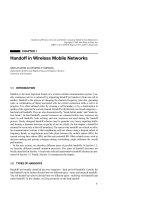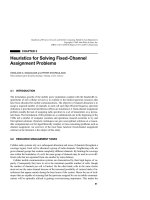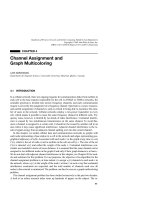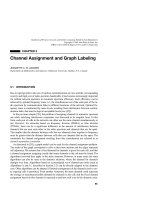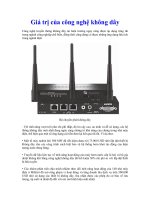Tài liệu Sổ tay của các mạng không dây và điện toán di động P3 pptx
Bạn đang xem bản rút gọn của tài liệu. Xem và tải ngay bản đầy đủ của tài liệu tại đây (99.88 KB, 20 trang )
CHAPTER 3
Heuristics for Solving Fixed-Channel
Assignment Problems
HARILAOS G. SANDALIDIS and PETER STAVROULAKIS
Telecommunication Systems Institute, Chania, Crete, Greece
3.1 INTRODUCTION
The tremendous growth of the mobile users’ population coupled with the bandwidth re-
quirements of new cellular services is in contrast to the limited spectrum resources that
have been allocated for mobile communications. The objective of channel allocation is to
assign a required number of channels to each cell such that efficient frequency spectrum
utilization is provided and interference effects are minimized. A fixed-channel assignment
problem models the task of assigning radio spectrum to a set of transmitters on a perma-
nent basis. The formulation of this problem as a combinatorial one in the beginning of the
1980s led a number of computer scientists and operations research scientists to try and
find optimal solutions. Heuristic techniques can give near-optimal solutions at a reason-
able computational cost for algorithmically complex or time-consuming problems such as
channel assignment. An overview of the most basic heuristic fixed-channel assignment
schemes in the literature is the subject of this study.
3.2 RESOURCE MANAGEMENT TASKS
Cellular radio systems rely on a subsequent allocation and reuse of channels throughout a
coverage region. Each cell is allocated a group of radio channels. Neighboring cells are
given channel groups that contain completely different channels. By limiting the coverage
area within the boundaries of a cell, the same group of channels may be used to cover dif-
ferent cells that are separated from one another by some distance.
Cellular mobile communication systems are characterized by their high degree of ca-
pacity. Consequently they have to serve the maximum possible number of calls, though
the number of channels per cell is limited. On the other hand, cells in the same cluster
must not use the same channel because of the increased possibility of various kinds of in-
terference that appear mainly during the busy hours of the system. Hence the use of tech-
niques that are capable of ensuring that the spectrum assigned for use in mobile communi-
cations will be optimally utilized is gaining ever-increasing importance. This makes the
51
Handbook of Wireless Networks and Mobile Computing, Edited by Ivan Stojmenovic´
Copyright © 2002 John Wiley & Sons, Inc.
ISBNs: 0-471-41902-8 (Paper); 0-471-22456-1 (Electronic)
tasks of resource management more and more crucial [44]. Some of the important objec-
tives of resource management are the minimization of the interference level and handoffs
as well as the adaptation to varying traffic and interference scenarios. Due to the time- and
space-varying nature of the cellular system, the radio resource management tasks need to
adapt to factors such as interference, traffic, and propagation environment. Some of the
radio resource management tasks performed by cellular systems include admission con-
trol, power control, handoff, and channel assignment [58]:
ț Frequency management and channel assignment. The proper management of fre-
quencies is very important in the development of a good communications plan be-
cause the available electromagnetic spectrum is highly congested. During the plan-
ning stage, if proper care is not taken in selecting frequencies, the frequencies
chosen may interfere with each other. Channel assignment is the process that allo-
cates calls to the channels of a cellular system. The main focus on research concern-
ing channel assignment is to find strategies that give maximal channel reuse without
violating the interference constraints so that blocking is minimal.
ț Handoff. Handoff is the mechanism that transfers an ongoing call from one base sta-
tion (BS) to another as a user moves through the coverage area of a cellular system.
Therefore, it must be fast and efficient to prevent the quality of service from degen-
erating to an unacceptable level. This is probably the most sensitive aspect of the
mobility provision and is an essential element of cellular communications, since the
process chosen for handoff management will affect other mobility issues.
ț Admission control. Whenever a new call arrives (or a request for service or a hand-
off), the radio resource management system has to decide if this particular call may
be allowed into the system. An algorithm making these decisions is called an admis-
sion control algorithm and prevents the system from being overloaded. New and
continuing calls can be treated differently. For example, handoffs may be prioritized,
new calls may be queued, etc.
ț Power control. In cellular networks, it is desirable to maintain bit error rates above a
chosen minimum. This would require the carrier to interference ratio of the radio
links be maintained above a corresponding minimum value for the network. Power
control is a specific resource management process that performs this task.
It is evident that an integrated radio resource management scheme can make necessary
trade-offs between the individual goals of these tasks to obtain better performance and in-
crease system capacity within specified quality constraints. However, a combination of in-
dividual radio resource management tasks is also possible. For example, handoff and
channel assignment tasks, or power control assisted admission schemes can be combined
to provide interesting results [55].
3.3 INTERFERENCE IN CELLULAR SYSTEMS
The major factor that determines the number of channels with a predetermined quality is the
level of received signal quality that can be achieved in each channel. This level strongly de-
52
HEURISTICS FOR SOLVING FIXED-CHANNEL ASSIGNMENT PROBLEMS
pends on the interference effects. Some possible sources of interference may be another car-
rier in the same cell, a call in progress in a neighboring cell, other base stations operating in
the same frequency band, or any noncellular system that radiates in the same frequency
band. Interference on voice channels causes crosstalk—the subscriber hears interference in
the background due to another call. On control channels, interference leads to missed calls
and blocked calls. Interference is more severe in urban areas, due to industrial interference
and a large number of base stations and mobiles in the proximity. It has been recognized as
a major bottleneck in increasing capacity. Interference to a channel that serves a particular
call occurs mainly when a user in an adjacent cell uses the same channel (cochannel inter-
ference), a user in the same region uses an adjacent channel (cosite interference), or a user
in an adjacent region uses an adjacent channel (adjacent channel interference) [28].
3.3.1 Cochannel Interference
Frequency reuse increases the system’s spectrum efficiency, but interference due to the
common use of the same channel may occur if the system is not properly planned. This
kind of interference is called cochannel interference. Cochannel interference is the most
critical of all interferences that occur in cellular radio; it depends on cellular traffic. The
possibility of cochannel interference appearing is greater in the busy hours of a cellular
system. The total suppression of cochannel interference is achieved by not using the fre-
quency reuse concept, which is contradictory to the whole idea of the cellular radio. Thus,
in order to obtain a tolerable value of cochannel interference, the system planner has to
take into account the reuse distance D.
When the size of each cell in a cellular system is roughly the same, cochannel interfer-
ence is independent of the transmitted power and becomes a function of the radius of the
cell R and the reuse distance D. The factor
Q = = ͙3
ෆ
·K
ෆ
(3.1)
is called the cochannel interference reduction factor or reuse factor and is the measure of
cochannel interference. The Q factor determines spectral efficiency within a cell and is re-
lated to the number of cells in the cluster K.
Assuming that all the cells transmit the same power, the frequency reuse distance D can
be increased by increasing K. One could expect that by making K as large as possible, all
problems concerning cochannel interference could be solved. An advantage of large clus-
ters is the fact that the interference from cochannel cells decreases because the distance be-
tween the cochannel cells also increases with the increase in cluster size. On the other hand,
the available bandwidth and therefore the available number of channels is fixed. When K is
large, the number of channels per cell is small. That causes spectrum inefficiency.
3.3.2 Cosite and Adjacent Channel Interference
In addition to cochannel interference, a second source of noise is the interference between
two adjacent channels of the same (cosite interference) or adjacent cells (adjacent channel
D
ᎏ
R
3.3 INTERFERENCE IN CELLULAR SYSTEMS
53
interference). It should be noted that the adjacent channel here is not the close neighboring
channel in a strict communication sense, but rather the nearest assigned channel in the
same cell and can be several channels apart.
Cosite and adjacent channel interference result from equipment limitations, mainly
from imperfect receiver filters that allow nearby frequencies to leak into the passband.
The problem can be particularly serious if one adjacent channel user is transmitting in
close range to a receiver that is attempting to receive a weaker signal using a neighbor-
ing channel. Several techniques can be used in order to solve this problem. The total fre-
quency spectrum is usually split into two halves so that the reverse channels that com-
pose the up-link (mobile to base station) and the forward channels that compose the
down-link (base station to mobile) can be separated by half of the spectrum. If other ser-
vices can be inserted between the two halves, then a greater frequency separation can be
attained [19].
Cosite and adjacent channel interference can also be minimized through careful chan-
nel assignments. By keeping the frequency separation between each channel in a given
cell as large as possible, these types of interference may be reduced considerably. Some
designers also prevent a source of adjacent channel interference by avoiding the use of ad-
jacent channels in geographically adjacent cell sites. This strategy, however, is dependent
on the cellular pattern. For instance, if a seven-cell cluster is chosen, adjacent channels are
inevitably assigned to adjacent cells.
3.3.3 Intermodulation
Intermodulation distortion (IMD) is a nonlinear phenomenon that occurs when some mul-
tiplexed frequency channels go through a nonlinear device such as a power amplifier. The
nonlinear characteristic of such a device generates several undesired cross-modulation
terms, mainly at frequencies 2f
i
– f
j
, 3f
i
– 2f
j
, f
i
+ f
j
– f
k
and 2f
i
+ f
j
– 2f
k
where i, j, and k
range over N, the total number of frequencies present. These terms may fall inside the de-
sired band of interest and therefore may affect the carrier-to-noise ratio performance links
used in cellular systems. Equal channel spacing may create problems in the sense that it
increases the number of intermodulation distortion terms that fall on the desired frequen-
cy channels. Therefore the number of intermodulation distortion terms are affected by the
channel assignment scheme used [26].
3.4 FREQUENCY MANAGEMENT AND CHANNEL ASSIGNMENT ISSUES
Efficient spectrum resource management is of paramount importance due to increasing
demands of new services, rapid and unbalanced growth of radio traffic, and other fac-
tors. A given radio spectrum (bandwidth) dedicated for cellular communications can be
divided into a set of disjoint and noninterfering radio channels. Techniques such as fre-
quency, time, and code division can be used in order to divide the radio spectrum. In fre-
quency division, the spectrum is divided into frequency bands. In time division, the us-
age of the channel is divided into time slots that are disjoint time periods. Finally, in
code division, the channel separation is achieved by using different modulation codes.
54
HEURISTICS FOR SOLVING FIXED-CHANNEL ASSIGNMENT PROBLEMS
Moreover, other techniques based on the combination of the above methods can be used
[28].
Since the radio spectrum is finite in mobile radio systems, the most significant chal-
lenge is to use the radio-frequency spectrum as efficiently as possible. Geographic loca-
tion is an important factor in the application of the frequency reuse concept in mobile cel-
lular technology to increase spectrum efficiency. The techniques for increasing the
frequency spectrum can be classified as [37]:
ț Increase the number of radio channels
ț Improve spatial frequency spectrum reuse
ț Use proper frequency management and channel assignment techniques
ț Improve spectrum efficiency in time
ț Reduce the load of invalid calls (call forwarding, queuing, etc.)
The function of frequency management is to divide the total number of available chan-
nels into subsets that can be assigned to each cell either in a fixed fashion or dynamically.
The terms frequency management and channel assignment are often confused. Frequency
management refers to designating set-up channels and voice channels, numbering the
channels, and grouping the voice channels into subsets (done by each system according to
its preference). Channel assignment has to do with the allocation of specific channels to
cell sites and mobile units. A fixed channel set that consists of one or more subsets is as-
signed to a cell site on a long-term basis. During a call, a specific channel is assigned to a
mobile unit on a short-term basis [37].
Frequency planning is therefore one of the most challenging tasks in designing a cellu-
lar mobile network. An accurate radio planning tool is essential for calculating predicted
signal strength coverage and interference levels and satisfying the overall grade of service.
The allocation of frequency channels to cells in a cellular network is a critical element of
the design process since it affects the two major metrics of any cellular network: capacity
and quality of service. The basic input data of a good frequency planning algorithm are
the numbers of required channels for each cell and interference probabilities between each
pair of cells using the same (cochannel interference) or adjacent channels (adjacent chan-
nel interference) of a certain band. This data is usually provided by measurements or by
simulation of radio wave propagation in the areas of interest.
Different benefit criteria should be taken into account when allocating channels to base
stations. First of all, the interference between each pair of cells must not exceed a certain
maximum threshold. This can be expressed using a proper compatibility matrix, which is a
squared matrix that has as many rows or columns as cells in the system. The element val-
ues of the matrix represent the minimum allowable distance between channels in two
cells. Channels should be allocated as to satisfy all traffic requirements per cell while ob-
serving the compatibility constraints.
The assumptions regarding interference require the use of a large margin in the mini-
mum acceptable signal-to-interference ratio in order to cope with the variations in the de-
sired received and interference signals on both links. These signal variations are basically
due to:
3.4 FREQUENCY MANAGEMENT AND CHANNEL ASSIGNMENT ISSUES
55
ț Propagation conditions, due to path loss and fading appearance.
ț User mobility—when the mobile approaches the cell boundary, the cochannel inter-
ference at the mobile increases.
ț Traffic load—if more users share the same channel, cochannel interference in the
system increases.
Moreover, it is important to spread channels within individual cells as far as possible.
Careful design in order to avoid the appearance of intermodulation effects should also
take place. Frequencies should be established such that no significant intermodulation
products from any combination of cosited transmitter frequencies fall on any other chan-
nel in use in that vicinity. This usually implies third- and fifth-order compatibility. In
densely populated areas, this strategy is difficult to implement completely, but in order to
avoid unwanted mobile receiver outputs resulting from interference, implementation of at
least third-order compatible frequency plans is highly desirable.
3.5 CHANNEL ASSIGNMENT
Channel assignment is a fundamental task of resource management that increases the fi-
delity, capacity, and quality of service of cellular systems by assigning the required num-
ber of channels to each cellular region in such a way that both efficient frequency spec-
trum utilization is provided and interference effects are eliminated. The channel allocation
strategy can be seen as a method of assigning available channels to calls originating in the
cells. If the strategy is unable to assign a channel, the call is blocked. The basic goal to be
achieved by channel allocation techniques under the prism of the rapidly growing demand
for cellular mobile services is to efficiently utilize the available spectrum so as to achieve
optimum system performance.
The main focus on research concerning channel assignment is to find strategies that
give maximal channel reuse without violating the constraints so that blocking is minimal.
Constraints can be classified into three categories [14]:
1. The frequency constraint specifies the number of available frequencies (channels)
in the radio spectrum. This constraint is imposed by national and international regu-
lations.
2. The traffic constraints specify the minimum number of frequencies required by
each station to serve a geographic area. These constraints are empirically deter-
mined by the telecommunications operators.
3. The interference constraints are further classified as:
ț The cochannel constraint—the same channel cannot be assigned to certain pairs
of radio cells simultaneously.
ț The adjacent channel constraint—frequencies adjacent in the frequency domain
cannot be assigned to adjacent radio cells simultaneously.
ț The cosite constraint—any pair of channels assigned to a radio cell must occupy
a certain distance in the frequency domain.
56
HEURISTICS FOR SOLVING FIXED-CHANNEL ASSIGNMENT PROBLEMS
Constraints in the frequency assignment problem are therefore multiple and some of
them are conflicting. The most severe limitation is the frequency constraint. This con-
straint imposes a high degree of frequency reuse by the stations and consequently increas-
es the difficulty of satisfying the interference constraints.
Most channel assignment schemes are quite detailed and founded largely on ad-hoc
principles. Moreover the channel assignment schemes are evaluated using different bench-
marks following extended simulations with a variety of assumptions regarding the mobile
radio environment. Some of these assumptions might be the cellular topology, the differ-
ent choice of reuse factors, the use of different traffic patterns, the incorporation of propa-
gation factors, the use of mobility, etc. The combination of these factors makes a system-
atic comparison of the various channel allocation methods quite infeasible and a true
decision of the best scheme is difficult to attain.
Roughly speaking, channel assignment is generally classified into fixed and dynamic
assignment. In fixed channel assignment (FCA), channels are nominally assigned to cells
in advance according to the predetermined estimated traffic intensity. In dynamic channel
assignment (DCA), channels are assigned dynamically as calls arrive. The latter method
makes cellular systems more efficient, particularly if the traffic distribution is unknown or
changes with time, but has the disadvantage of requiring more complex control and is
generally time consuming. Various extensions or combinations of the above two schemes
have been discussed in the literature. The most basic ones are hybrid channel assignment
(HCA) and borrowing channel assignment (BCA). In HCA, the set of the channels of the
cellular system is divided into two subsets; one uses FCA and the other DCA. In the BCA
scheme, the channel assignment is initially fixed. If there are incoming calls for a cell
whose channels are all occupied, the cell borrows channels from its neighboring cells and
thus call blocking is prevented.
FCA is the simplest off-line allocation scheme. It has been used as the primary alloca-
tion technique for first- and second-generation cellular systems and outperforms DCA
and other schemes under uniform and heavy traffic loads. Moreover FCA problems can
serve as bounds for the performance of HCA and DCA schemes. For these reasons, FCA
constitutes a significant research subject for the operations research, artificial intelli-
gence, and mobile communication fields [34].
3.6 FIXED-CHANNEL ASSIGNMENT PROBLEM
A lot of existing systems are operating with fixed-channel assignment, in which channels
are permanently assigned to cells for exclusive use. Cells that have the same reuse dis-
tance can use the same channels. This uniform channel distribution is efficient if the traf-
fic distribution of the system is also uniform. However, for nonuniform traffic environ-
ments, a uniform channel distribution results in poor channel utilization. Cells in which
traffic load is high may not have enough channels to serve calls, whereas spare channels
may exist in some other cells with low traffic conditions. It is, therefore, appropriate to
use nonuniform channel distribution. In this case, the number of nominal channels as-
signed to each cell depends on the expected traffic profile in that cell. Hence, heavily
loaded cells are assigned more channels than lightly loaded ones.
3.6 FIXED-CHANNEL ASSIGNMENT PROBLEM
57
FCA is also shown to be sensitive to temporal and spatial traffic variations and hence is
not able to attain a high degree of channel efficiency. However, this scheme is very simple
in design and is very efficient for stationary, heavy traffic loads. In fact, the greatest ad-
vantage of FCA is the low call service time. Due to the already assigned channels among
cells, the process of finding a channel to serve a call does not require elaborate control.
Hence, calls do not have to wait and are either served or blocked.
In order to achieve better performance in mobile networks operating with the FCA,
proper frequency planning is required. The available frequency band is usually partitioned
into a set of channels having the same bandwidth of frequencies, and channels are num-
bered from 1 to a given maximum N. In fact, a mobile user needs two channels—the first
one for the mobile-to-base station link and the second for the base-to-mobile station link.
However, as these two channels are assigned together, a lot of studies consider a channel
to contain only one link.
A cellular network can be described by a weighted graph in which the nodes corre-
spond to the cells or the transmitters and the edges join nodes that correspond to adjacent
cells or transmitters in the network. The weight of the edges (0, 1, 2) represents the sepa-
ration that the frequencies corresponding to the cells or transmitters should have between
each other in order to prevent interference. Hence, the frequency assignment problem
(FAP) can be treated as a graph coloring problem in which the main task is to assign col-
ors (frequencies) to the nodes so that the absolute difference between the colors of any
pair of nodes is at least the weight of the edge joining them.
The interference constraints in a cell network are usually described by an N × N sym-
metric matrix called compatibility matrix C. The compatibility matrix is a matrix whose el-
ements give the separation that should exist between the channels corresponding to the cell
row and the cell column. This separation is represented by a natural number with values 0,
1, 2, etc. An element equal to 0 means that the two cells do not interfere and therefore the
same channel may be reused. In this case, mobile stations located in each cell can share the
same channel. An element equal to 1 means that the transmitters located in these cells must
use channels that maintain a minimum separation of one unit. That is, cochannel interfer-
ence between the two transmitters is unacceptable but interference of adjacent channels is
allowed. This situation corresponds to neighboring cells . An element equal to 2 or higher
means that these cells must use channels separated by at least two units. This is usually re-
quired for channels in the same cell, depending on the base station equipment [1].
Based on the previous comments, a general formulation of a N × N compatibility ma-
trix C is:
C =
΄΅
(3.2)
where if c
ij
= c
jj
there is cosite constraint
c
ij
= 0 there is no constraint in channel reuse
c
ij
= 1 there is cochannel constraint
c
ij
Ն 2 there is adjacent channel constraint
c
1N
c
2N
Ӈ
c
NN
...
...
.
.
.
...
c
12
c
22
Ӈ
c
N2
c
11
c
21
Ӈ
c
N1
58
HEURISTICS FOR SOLVING FIXED-CHANNEL ASSIGNMENT PROBLEMS

